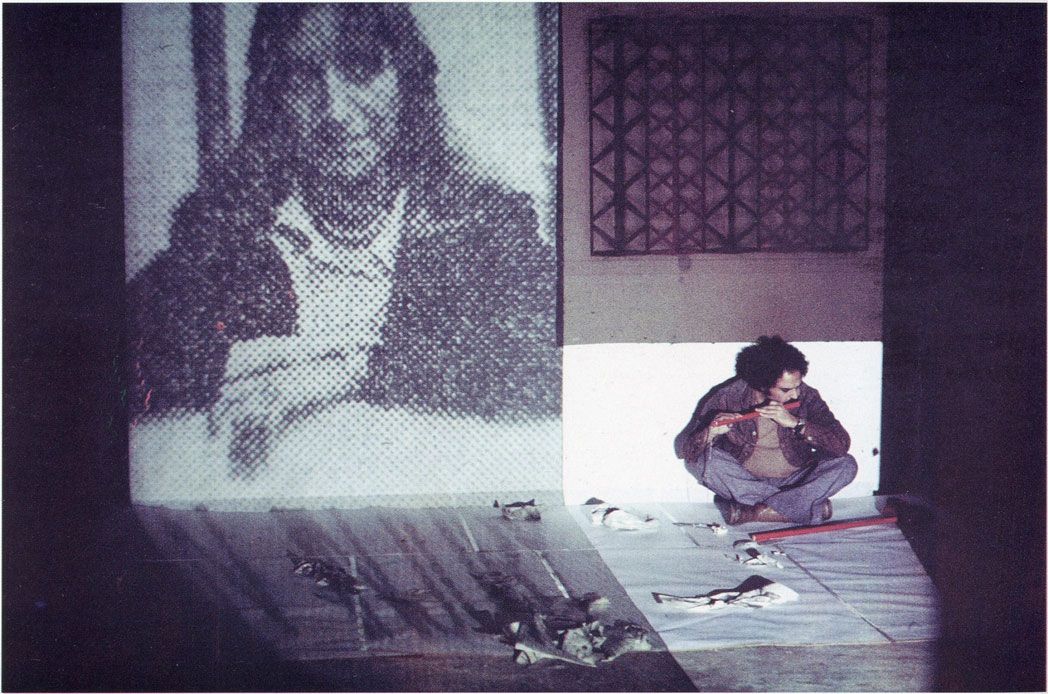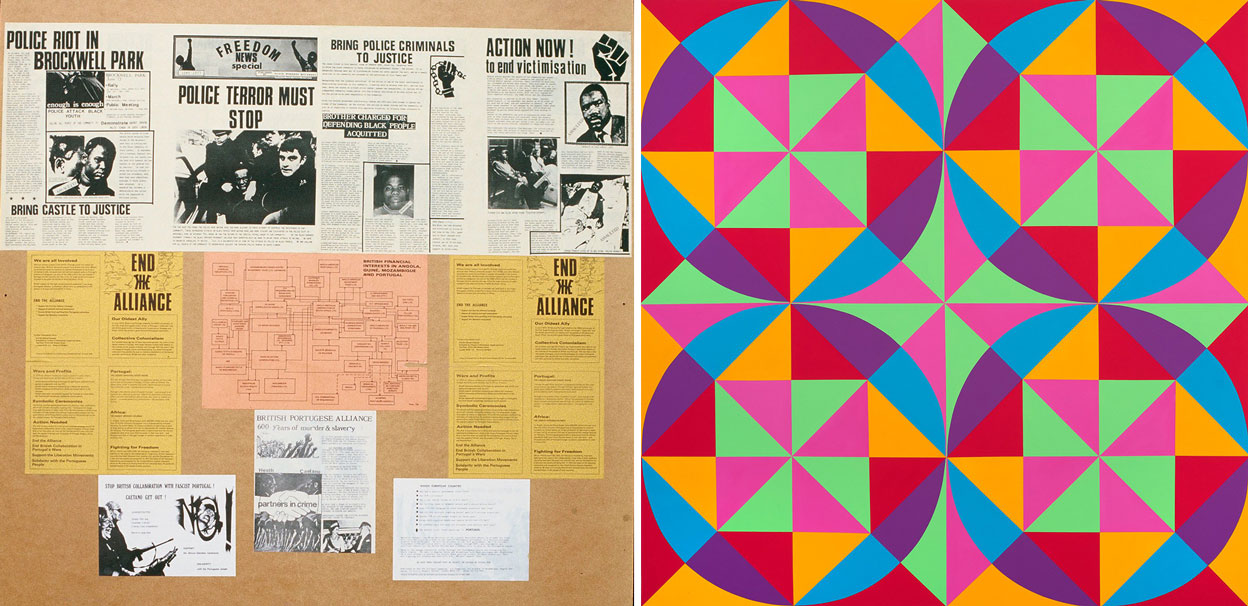ART-PRESENTATION: Rasheed Araeen-A Retrospective
 The exhibition “Rasheed Araeen: A Retrospective” that is on presentation at the Garage Museum of Contemporary Art is the first comprehensive survey in Russia of the artist. Spanning 60 year of work the exhibition is structured across five chapters: from his early experiments in painting in Karachi in the 1950s and early 60s, his pioneering minimalist sculptures carried out after his arrival in London in 1964, key pieces from the 70s and 80s following Araeen’s political awakening, his nine panel cruciform works from the 80s and 90s and a selection of his new geometric paintings and wall structures.
The exhibition “Rasheed Araeen: A Retrospective” that is on presentation at the Garage Museum of Contemporary Art is the first comprehensive survey in Russia of the artist. Spanning 60 year of work the exhibition is structured across five chapters: from his early experiments in painting in Karachi in the 1950s and early 60s, his pioneering minimalist sculptures carried out after his arrival in London in 1964, key pieces from the 70s and 80s following Araeen’s political awakening, his nine panel cruciform works from the 80s and 90s and a selection of his new geometric paintings and wall structures.
By Efi Michalarou
Photo: Garage Museum of Contemporary Art Archive
The exhibition “Rasheed Araeen: A Retrospective” shows how Rasheed Araeen struggled with institutional racism and worked on making art that is open to everyone, both as a practice and as a set of meanings. Araeen’s retrospective can also be seen as a valuable alternative to the usual understanding of the Avant-Garde’s reception across the world. Known for his strident critique of the ideological and political assumptions of Western Modernism, Araeen trained as an engineer in Karachi, before moving to London in 1964 in pursuit of an artistic career. There, he first became known as a pioneering sculptor and installation artist in the (then) emerging field of minimalism, receiving the prestigious John Moores Prize for sculpture in 1969. Against the tumultuous background of financial crisis and increasing hostility to immigrants in the 1970s, Araeen’s art took a sharp political turn, addressing head-on the problems of Britain’s institutional racism both outside and within the art world. In the early 1970s, having won prizes but because of his ethnicity, nevertheless struggling to find gallery representation, Araeen had what he describes as “a political awakening”. He joined the Black Panther Movement, of which South Asians formed a core, and large-scale photographic collages, like the gridded contact sheet “When They Meet” (1973), record the street battles he had with the National Front. In 1975–76, he wrote his “Preliminary Notes for a BLACK MANIFESTO”, a long essay, much of it in uppercase, that called for the “Denunciation of and confrontation with the imperialist culture and the system that perpetuates international domination’. The activist works that followed, including his performance piece “Paki Bastard (Portrait of the Artist as a Black Person)” (1977), influenced a new, multicultural generation of artists. He began writing extensively in 1975, and in 1977 presented a multimedia work, Paki Bastard, that conflated performance, film, and sound. A year later, he initiated Black Phoenix, a publication on Black art in Britain, and started using Urdu (his native language) as part of his work addressing decolonization and the complex identity of a Commonwealth artist. In the 1980s Araeen established his first institutional structures, “Project MRB” (1982), “Kala Press”, and “Black Umbrella” (1984) which defined itself as the “AfroAsian Peoples’ Visual Arts Resource & Information Centre”. Primarily self-funded, this is the name under which Araeen has since developed his expanded practice, including the ground-breaking journal, “Third Text”, which he established in 1987. The artist also began curating in the 1980s, most notably “The Other Story” (1989) at the Hayward Gallery, with 24 British African, Caribbean, and Asian artists. In this exhibition Araeen articulated a sentiment that he has been championing his entire career: that until Black artists are written into the canon of art history on the basis of their contribution to modernism, there is no common ground from which to tell or analyze the story of postwar art. The last five years have seen a world-wide reappraisal of Araeen’s work, including large-scale projects at Documenta 14 in Kassel and Athens, and the Venice Biennial (both 2017), as well as the Sharjah Art Foundation (2014) and Tate Modern (2013) and spaces in Sao Paolo (2016), Dubai and Hong Kong (2015), Karachi (2014), and Peru (2013). Especially for Garage, Araeen developed an Atrium Commission, producing a sculpture he first envisaged in 1968. In a gesture that puts the artist in dialogue with the glorious and troubled history of the Russian avant-garde, Homage to Tatlin directly references Vladimir Tatlin’s “Monument to the 3rd International”, suggesting a kinship of non-Western modernities. Especially for Garage, Araeen developed an Atrium Commission, producing a sculpture he first envisaged in 1968. In a gesture that puts the artist in dialogue with the glorious and troubled history of the Russian avant-garde, “Homage to Tatlin” directly references Vladimir Tatlin’s “Monument to the 3rd International”, suggesting a kinship of non-Western modernities. In the fifty years since Rasheed Araeen made the first small-scale model of “Homage to Tatlin” in 1968, his practice has undergone many transformations the artist been involved in the making of numerous important exhibitions and publications. Today, the 7.5-meter sculpture “Homage to Tatlin” embodies Araeen’s very personal vision of the formal and political ambitions of the Russian avant-garde. Working within a broad cultural context, Araeen sees the avant-garde, along with minimalism and Islamic interlocking patterns, as episodes in the “journey of an idea, in which geometry was used to produce a situation of equality between the artwork, the viewer, and the artist (and in the future, perhaps, a situation of political equality”. As part of the exhibition the project “A Cultural Atlas” by the artist and researcher Vali Mahlouji is shown on the Museum’s mezzanine. The project reconstructs a complex space of international modernity by tracing a cultural atlas through which knowledge was exchanged across alternative (often non-European) plateaus. By the middle of the last century, the demise of the old European empires revealed a new horizon of opportunities and encounters for people and cultures across the world. The atlas serves as an evocation of the constantly evolving dreams and possibilities that emerged and dissolved during the period. Intended as a living object, the cultural atlas mutates with each re-instalment. It remains a deliberately unfixed, unfinished and unstable process, like the ideas and connections it conjures, designed to be animated by the spaces that it arrives in. To that effect, the cultural atlas is a live project. Audience are encouraged to interrupt, intercept, and shape the color and tone of its evolution, and to expand its cosmos by proposing new links and initiating new constellations, unearthing the shifting sites of utopias across the twentieth century based on their local context and experience.
Info: Curator: Nick Aikens in collaboration with Kate Fowle, Iaroslav Volovod, and Valentin Diaconov, Garage Museum of Contemporary Art, Krymsky Val, 9 строение 32, Moscow, Duration: 8/3-16/5/9, Days & Hours: Daily 11:00-22:00, https://garagemca.org







